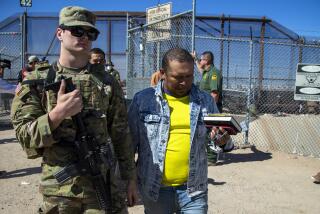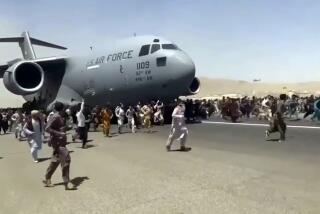Obama’s Afghan war strategy: End it
- Share via
What are President Obama’s intentions in Afghanistan?
He told us 10 months ago, at the conclusion of an agonizing, weeks-long strategy debate, that he would give his generals the 33,000 additional troops they wanted and 18 months to show what they could do with them. Then we would begin drawing down. But did he mean it?
Bob Woodward’s new book, “Obama’s Wars,” for all its reconstructed conversations and unspecified sourcing, is at its most useful in helping answer that question. It helps clarify where things stand inside the Obama administration as it must decide whether to stick to the timetable it laid out.
According to Woodward, Obama is determined to get out of this war. Time and again in the narrative, we hear the president say he’s looking not for victory but for closure. “I want an exit strategy,” he’s quoted as saying. “This needs to be a plan about how we’re going to hand it off and get out of Afghanistan.” What worries him most, it seems, is the “opportunity cost” that the war exacts — the money and attention it’s diverting from other, more important priorities.
So when Obama decided late last year to cap the number of U.S. troops in Afghanistan at about 100,000 and begin drawing them down next July, he was serious. In recent weeks, aides to Gen. David H. Petraeus, the U.S. commander in the war, have begun suggesting they might seek an extension of that deadline — to October instead of July, for example — to improve their chances of success. But if Woodward has it right, that won’t happen.
Woodward does show a deep divide in this administration between hawks and doves, but the doves include all the people closest to Obama. The White House is populated by Democratic political aides who don’t want to continue this war and don’t think Petraeus’ plans are likely to succeed. The Pentagon, on the other hand, is led largely by counterinsurgency enthusiasts who think Petraeus can succeed if the White House gives him enough troops and enough time.
Last year, Defense Secretary Robert M. Gates and Secretary of State Hillary Rodham Clinton sided with the hawks, and their voices helped tip the balance in favor of escalation. But that balance may have shifted by the next time a decision has to be made. One of the most important results of last year’s White House debate on Afghanistan, according to Woodward, may have been the lesson Obama learned from it: Don’t trust everything the generals tell you.
Time and again, in Woodward’s telling, military leaders gave the president only one real option for the war — the option the generals preferred — and resisted opening the discussion to alternatives. White House aides fumed at the generals’ recalcitrance, but in the end Obama essentially bowed to their wishes, giving them almost as many troops as they requested (and, the generals admit, a number that was probably their bottom line all along).
Next year’s decision, though, will be made under different conditions. By July, Petraeus will have been running the war for a year with all the troops he wanted; if his strategy isn’t working by then, it will be difficult to hide. Gates, the most influential exponent of a robust pursuit of the war, will be on his way out the door if he’s not already gone. (The Defense secretary has said he has made up his mind to leave next year, and sounds as if he prefers sooner to later.) And though the president has said that any withdrawal will be based on conditions on the ground, two of the conditions on Obama’s mind will be the approaching 2012 election and the public’s weariness with the war. Those factors seem likely to strengthen the doves, not the hawks.
For the moment, the White House and the Pentagon have a somewhat rocky truce, with both sides sticking to the bargain they made last December to give Petraeus a chance to make his strategies work. “They haven’t failed yet; they haven’t succeeded yet,” Obama said in a recent interview with Rolling Stone magazine
The White House has even cut the generals a few months’ slack: A looming December strategy review, originally intended to decide whether the strategy was working, has now been downgraded to, as Adm. Michael Mullen, chairman of the Joint Chiefs of Staff, put it, “a review of the implementation” rather than “a review of the strategy.”
The problem, of course, is that in counterinsurgency, if the government side isn’t winning, it’s losing. A stalemate — a tie — goes to the insurgents. You’ve got the watches, the Taliban is reputed to say, but we’ve got the time.
When Obama imposed his July 2011 deadline, he said he intended it, in part, to speed up the Afghan government’s training and deployment of its own security forces and encourage them to take decisive action against corruption. Only half of that equation has worked. The Afghan security forces are slowly improving, but President Hamid Karzai has stubbornly resisted any serious political reform.
When July rolls around, we’re almost certain to be looking at a situation that’s still ambiguous: a mixed picture of progress and stalemate on the military side and an unsatisfying standoff with Karzai on the political side. Petraeus and the generals will ask for more time (not more troops — they know that’s a nonstarter). Obama will insist on starting his drawdown.
“I have two years with the public on this,” Woodward quotes him as saying. And, summoning the ghost of Lyndon B. Johnson: “I’m not signing on to a failure. If what I proposed is not working, I’m not going to be like these other presidents and stick to it based on my politics — my political security.”
That sounds like a man who meant what he said.
For much of the past year, it’s been difficult to determine exactly what Obama wants in Afghanistan. But it’s now clearer than ever that what he wants, above all, is to get out.
doyle.mcmanus@latimes.com
More to Read
Sign up for Essential California
The most important California stories and recommendations in your inbox every morning.
You may occasionally receive promotional content from the Los Angeles Times.










